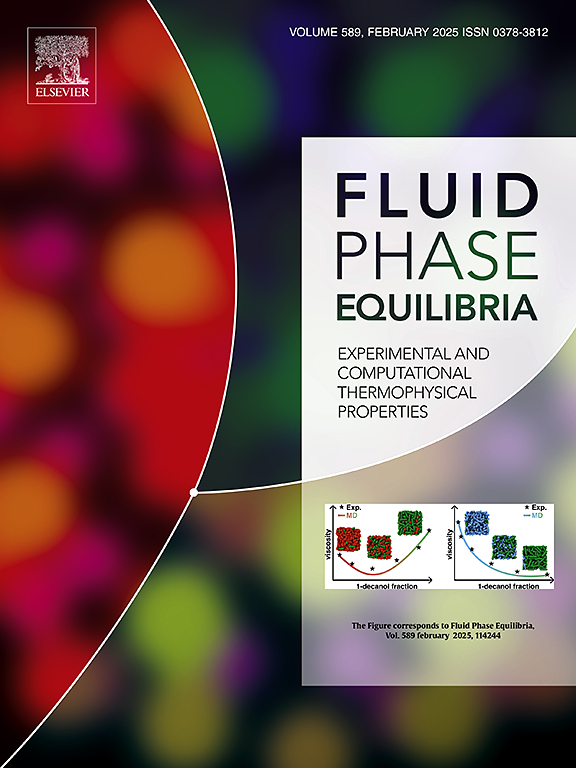Vapor-liquid-liquid equilibria for the water + 1-butanol + CPME mixture
IF 2.8
3区 工程技术
Q3 CHEMISTRY, PHYSICAL
引用次数: 0
Abstract
In this contribution we have carried out vapor-liquid-liquid equilibrium (VLLE) determinations for the Water + 1-Butanol + cyclopenthyl methyl ether (CPME) mixture, where no previous information is reported. Measurements were performed with a commercial Fisher VLE/VLLE 602 equilibrium cell at 101.3 kPa and the Wisniak's L/K test is used to ensure the thermodynamic consistency for the two pairs of V-La and V-Lo phases at VLLE. Additionally, we have predicted the three-phase line of this system by performing modified multiphase flash calculations coupled with a phase stability restriction, where the system was modelled with the SAFT-VR-Mie equation of state. The VLLE of the ternary mixture was excellently predicted by only fitting binary interaction parameters to the phase equilibrium of each constituent binary mixture. This system has two partially miscible binaries in Water + 1-Butanol and Water + CPME, which makes the ternary liquid-liquid system a type II equilibrium envelope. The two binaries are connected through a zeotropic three-phase line.

求助全文
约1分钟内获得全文
求助全文
来源期刊

Fluid Phase Equilibria
工程技术-工程:化工
CiteScore
5.30
自引率
15.40%
发文量
223
审稿时长
53 days
期刊介绍:
Fluid Phase Equilibria publishes high-quality papers dealing with experimental, theoretical, and applied research related to equilibrium and transport properties of fluids, solids, and interfaces. Subjects of interest include physical/phase and chemical equilibria; equilibrium and nonequilibrium thermophysical properties; fundamental thermodynamic relations; and stability. The systems central to the journal include pure substances and mixtures of organic and inorganic materials, including polymers, biochemicals, and surfactants with sufficient characterization of composition and purity for the results to be reproduced. Alloys are of interest only when thermodynamic studies are included, purely material studies will not be considered. In all cases, authors are expected to provide physical or chemical interpretations of the results.
Experimental research can include measurements under all conditions of temperature, pressure, and composition, including critical and supercritical. Measurements are to be associated with systems and conditions of fundamental or applied interest, and may not be only a collection of routine data, such as physical property or solubility measurements at limited pressures and temperatures close to ambient, or surfactant studies focussed strictly on micellisation or micelle structure. Papers reporting common data must be accompanied by new physical insights and/or contemporary or new theory or techniques.
 求助内容:
求助内容: 应助结果提醒方式:
应助结果提醒方式:


